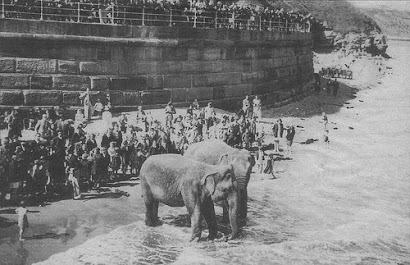Louis Tracy (1863 - 1928) was a newspaper journalist and a very prolific author. He was reputedly born in Liverpool (although that is disputed by Steve Holland in his Bear Alley blog) but lived a significant part of his life in Whitby. The census records for 1901 show that his son, Thomas resided at 23 Skinner Street, Whitby. Tracy himself gave his address in 1911 as Fairlawn, Whitby, Yorkshire.
He often collaborated with M. P. Shiel, author of The Purple Cloud, with whom he sometimes shared the pseudonyms Gordon Holmes and Robert Fraser.
 Tracy became a volunteer member of the Coast Guard, and in his book The Pillar of Light an exciting shipwreck takes place. It is clear that Tracy used his real life experiences in Whitby's Coast Guard to inform the thrilling description of the storm, wreck and rescue.
Tracy became a volunteer member of the Coast Guard, and in his book The Pillar of Light an exciting shipwreck takes place. It is clear that Tracy used his real life experiences in Whitby's Coast Guard to inform the thrilling description of the storm, wreck and rescue.The Shiel scholar John D. Squires has written a long article on Louis Tracy here. In August 2012 Mr Squires promised to furnish me with material about Tracy's life in Whitby, but he sadly died in November of that same year before any correspondence could take place. His message to me read:
I have info on Tracy's life in Whitby, including an (unfortunately) poor quality image of his home showing shell damage from the German cruiser raid. If you want to use on your blog, contact me.
This moving obituary to Tracy appeared in the October 1928 edition of The Bookman, the literary magazine.
I heard with great regret of the death of Mr. Louis Tracy, an able and successful novelist; whose books have enjoyed considerable popularity for the last thirty years. His first novel, The Final War, was published in 1896, and the strenuous work he undertook during that War when it came (for since it was a cold war to end war, one hopes it was the final one), broke down his health and hastened his end.
He was turned fifty in 1914, but promptly took a hand in forming the Whitby Branch of the North Riding Volunteer Reserve, and in 1915 was made sub-commander of the regiment. He wrote much on the War, went lecturing on it in America in 1916, and in 1917 joined the Headquarters Staff of the British Mission in the U.S.A., and later was temporarily attached to the Foreign Office. For these and other war services he was made a C.B.E. in 1920.
For six years most of his literary work was suspended, and at fifty eight he had to take up the dropped threads and begin again, and did not find the way easy after that interval, but wrote thirteen more novels in the last seven years, and regained his public, though he could not regain the strength he had lost. By a strange coincidence he died on August 13th, leaving unfinished a story called The Fatal Thirteen, of which he had written only thirteen pages.
He was turned fifty in 1914, but promptly took a hand in forming the Whitby Branch of the North Riding Volunteer Reserve, and in 1915 was made sub-commander of the regiment. He wrote much on the War, went lecturing on it in America in 1916, and in 1917 joined the Headquarters Staff of the British Mission in the U.S.A., and later was temporarily attached to the Foreign Office. For these and other war services he was made a C.B.E. in 1920.
For six years most of his literary work was suspended, and at fifty eight he had to take up the dropped threads and begin again, and did not find the way easy after that interval, but wrote thirteen more novels in the last seven years, and regained his public, though he could not regain the strength he had lost. By a strange coincidence he died on August 13th, leaving unfinished a story called The Fatal Thirteen, of which he had written only thirteen pages.
LINKS
A comprehensive bibliography of Tracy's work
Bear Alley
John D. Squires









